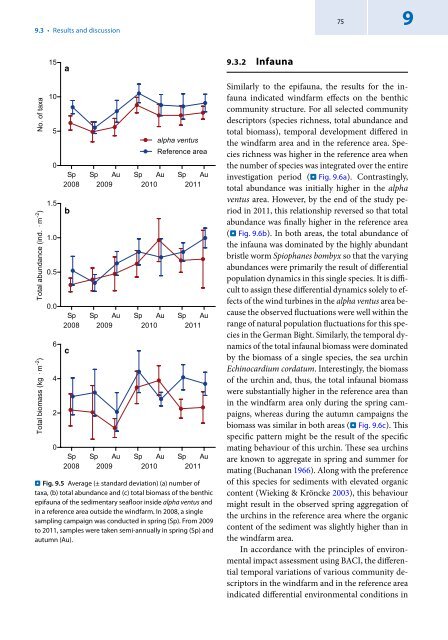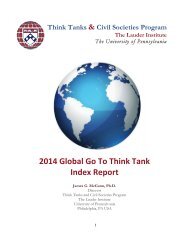bok%3A978-3-658-02462-8.pdf?auth66=1398409209_a0514c2b8e531c058ab8b810a0cad74d&ext=
bok%3A978-3-658-02462-8.pdf?auth66=1398409209_a0514c2b8e531c058ab8b810a0cad74d&ext=
bok%3A978-3-658-02462-8.pdf?auth66=1398409209_a0514c2b8e531c058ab8b810a0cad74d&ext=
- No tags were found...
Create successful ePaper yourself
Turn your PDF publications into a flip-book with our unique Google optimized e-Paper software.
9.3 • Results and discussion75 915a9.3.2 InfaunaNo. of taxaTotal abundance (ind. ⋅ m -2 )Total biomass (kg ⋅ m -2 )10501.51.00.50.06420alpha ventusReference areaSp Sp Au Sp Au Sp Au2008 2009 2010 2011bSp Sp Au Sp Au Sp Au2008 2009 2010 2011cSp Sp Au Sp Au Sp Au2008 2009 2010 2011..Fig. 9.5 Average (± standard deviation) (a) number oftaxa, (b) total abundance and (c) total biomass of the benthicepifauna of the sedimentary seafloor inside alpha ventus andin a reference area outside the windfarm. In 2008, a singlesampling campaign was conducted in spring (Sp). From 2009to 2011, samples were taken semi-annually in spring (Sp) andautumn (Au).Similarly to the epifauna, the results for the infaunaindicated windfarm effects on the benthiccommunity structure. For all selected communitydescriptors (species richness, total abundance andtotal biomass), temporal development differed inthe windfarm area and in the reference area. Speciesrichness was higher in the reference area whenthe number of species was integrated over the entireinvestigation period (. Fig. 9.6a). Contrastingly,total abundance was initially higher in the alphaventus area. However, by the end of the study periodin 2011, this relationship reversed so that totalabundance was finally higher in the reference area(. Fig. 9.6b). In both areas, the total abundance ofthe infauna was dominated by the highly abundantbristle worm Spiophanes bombyx so that the varyingabundances were primarily the result of differentialpopulation dynamics in this single species. It is difficultto assign these differential dynamics solely to effectsof the wind turbines in the alpha ventus area becausethe observed fluctuations were well within therange of natural population fluctuations for this speciesin the German Bight. Similarly, the temporal dynamicsof the total infaunal biomass were dominatedby the biomass of a single species, the sea urchinEchinocardium cordatum. Interestingly, the biomassof the urchin and, thus, the total infaunal biomasswere substantially higher in the reference area thanin the windfarm area only during the spring campaigns,whereas during the autumn campaigns thebiomass was similar in both areas (. Fig. 9.6c). Thisspecific pattern might be the result of the specificmating behaviour of this urchin. These sea urchinsare known to aggregate in spring and summer formating (Buchanan 1966). Along with the preferenceof this species for sediments with elevated organiccontent (Wieking & Kröncke 2003), this behaviourmight result in the observed spring aggregation ofthe urchins in the reference area where the organiccontent of the sediment was slightly higher than inthe windfarm area.In accordance with the principles of environmentalimpact assessment using BACI, the differentialtemporal variations of various community descriptorsin the windfarm and in the reference areaindicated differential environmental conditions in




